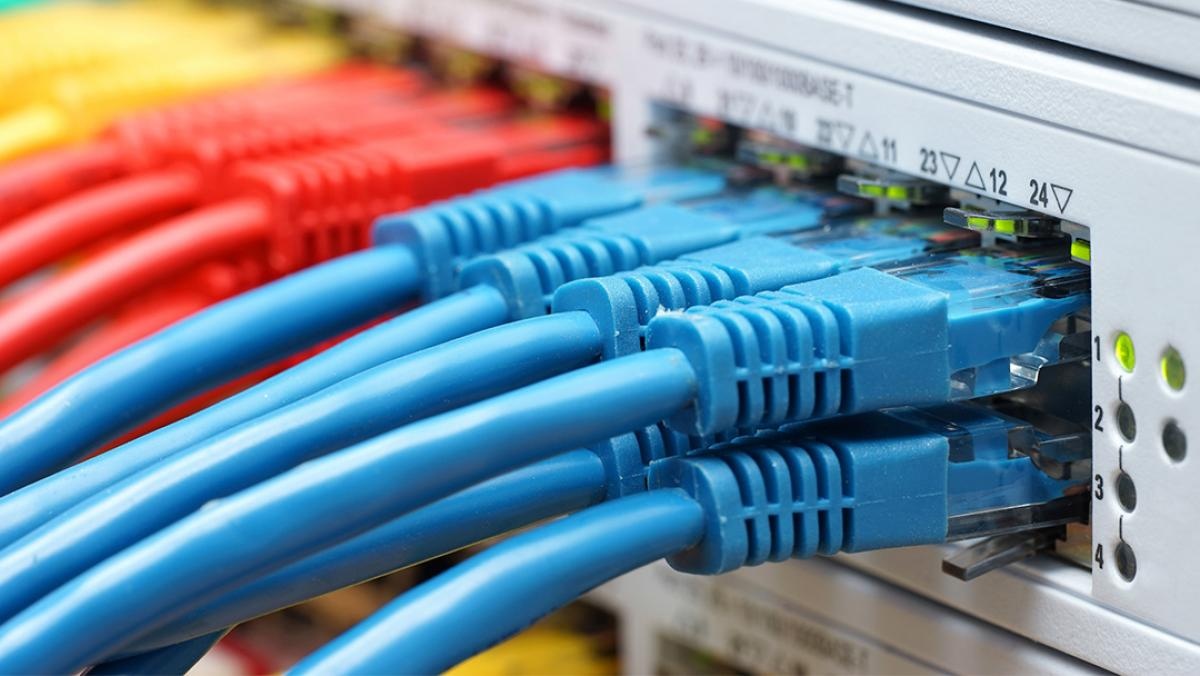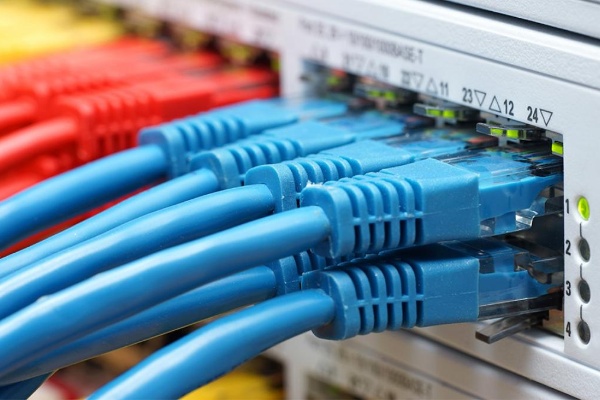在当今互联的世界中, 以太网是现代网络的支柱. 无论您是要设置家庭网络还是管理复杂的业务基础设施, 了解以太网至关重要. 但以太网到底是什么, 为什么它如此重要? 本指南将回答这些问题并全面概述以太网的历史, 标准, 成分, 优点, 和应用.

以太网基础知识
什么是以太网? 其核心, 以太网是一种有线网络技术,允许设备在局域网内进行通信 (局域网). 它有助于通过电缆或光纤以帧的形式传输数据, 确保快速可靠的连接.
以太网的故事始于 20 世纪 70 年代, 当罗伯特·梅特卡夫和他在施乐的团队开发出第一个版本时. 最初设计用于内部办公室使用, 以太网因其简单性而迅速受到关注, 可靠性, 和可扩展性. 几十年来, 它已经发展成为一种强大的技术,支持从小型家庭网络到广泛的企业系统的一切.
以太网的定义特征之一是它使用协议来控制数据的传输方式. 这确保设备可以不受干扰地发送和接收信息, 较早期技术有显着改进.
以太网标准
以太网的功能由 IEEE 管理 802.3 标准, 它定义了如何 设备在物理层进行通信 OSI 模型的数据链路层. 这些标准随着时间的推移而更新,以满足对速度和效率日益增长的需求.
以下是最常见的以太网标准:
– 经典以太网 (10 Mbps): 原来的标准, 现在基本上已经过时,但是现代发展的基础.
– 快速以太网 (100 Mbps): Introduced in the 1990s to meet growing demand for higher speeds in home and office environments.
– Gigabit Ethernet (1 千兆比特): A milestone for high-speed data transmission, now standard in most networks.
– 10-Gigabit Ethernet (10 千兆比特): Widely used in data centers and for high-performance computing.
– Beyond 10 千兆比特: Standards like 25G, 40G, and even 400G Ethernet cater to the needs of large-scale enterprise networks and advanced technologies such as AI and cloud computing.
These standards ensure that Ethernet remains versatile and adaptable to different networking needs, supporting both current and future applications.

Ethernet Components
An Ethernet network comprises several key components that work together seamlessly. Each component plays a critical role in ensuring efficient and reliable communication.
Ethernet Cables
– Twisted Pair Cables: These are the most commonly used cables, with options like Cat5e, Cat6, and Cat6a. Each category supports varying speeds and distances, with Cat6a offering improved shielding to reduce interference.
– Fiber Optic Cables: These cables use light to transmit data, making them ideal for long-distance and high-speed transmission. They are commonly used in enterprise and industrial settings.
Network Devices
– Switches: These devices connect multiple devices within a network, directing data to the correct destination efficiently.
– Routers: While switches handle internal communication, routers connect networks to the internet or other networks.
– Network Interface Cards (NICs): These are hardware components installed in devices to enable Ethernet connectivity.
Connectors
– RJ45 Connectors: Standard for twisted-pair cables, ensuring secure and stable connections.
– Fiber Optic Connectors: Specialized connectors used in fiber optic networks to ensure precise data transmission.

Key Advantages of Ethernet
Why choose Ethernet over other networking options? Here are its primary benefits:
– Speed: Ethernet provides faster data transmission than most wireless technologies, with options ranging from 10 Mbps to 400 千兆比特.
– Reliability: Ethernet ensures stable connectivity with minimal interference or signal loss, making it ideal for critical applications.
– Security: Wired connections are inherently more secure than wireless ones, reducing the risk of unauthorized access.
– Cost-Effectiveness: Ethernet cables and devices are widely available and affordable, offering excellent value for both individuals and businesses.
– Scalability: Ethernet networks can easily be expanded to accommodate growing needs, making them future-proof.
Moreover, Ethernet’s low latency and high performance make it a preferred choice for activities requiring uninterrupted connectivity, such as video streaming, gaming, and remote work.
Ethernet vs. Other Networking Technologies
When comparing Ethernet to other technologies like Wi-Fi or DSL, Ethernet stands out for its stability and performance. Here’s how it compares:
Ethernet vs. Wi-Fi: While Wi-Fi offers mobility, Ethernet delivers faster speeds, lower latency, and higher reliability. This makes Ethernet ideal for environments where consistent performance is crucial, such as offices and gaming setups.
Ethernet vs. DSL: DSL (Digital Subscriber Line) is an older technology primarily used for internet connections. Ethernet, on the other hand, is designed for both local and wide-area networks, offering superior speed and reliability.

Common Applications of Ethernet
Ethernet’s versatility makes it suitable for a wide range of applications:
– Home Networking: Connecting computers, smart TVs, gaming consoles, and more to ensure stable internet access.
– Business Networks: Building secure and scalable LANs for offices, ensuring seamless communication between employees and systems.
– Industrial Control Systems: Powering automation and IoT devices in factories and warehouses, where reliability is paramount.
– 数据中心: Facilitating high-speed communication between servers and storage devices to handle massive data loads efficiently.
From residential setups to enterprise-grade systems, Ethernet plays a critical role in connecting devices efficiently and reliably.
The Future of Ethernet
The future of Ethernet looks promising, with emerging technologies like 2.5G and 5G Ethernet gaining traction. These advancements promise faster speeds and greater flexibility, catering to the needs of modern applications such as AI, IoT, and smart cities.
Ethernet is also evolving to support greener technologies, with energy-efficient Ethernet (EEE) standards reducing power consumption without compromising performance. Furthermore, it continues to integrate seamlessly with wireless technologies like 5G, ensuring a balanced mix of speed and mobility.
Choosing the Right Ethernet Setup
Selecting the right Ethernet components is essential for optimizing your network:
1. 电缆: For home use, Cat5e or Cat6 cables are sufficient, while businesses may require Cat6a or fiber optics for greater performance.
2. Switches and Routers: Choose models that match your network’s size and complexity, ensuring they can handle your data demands.
3. Setup Tips: Organize cables neatly, avoid running them near electrical lines to reduce interference, and use quality components to minimize signal loss.
A properly configured Ethernet network ensures seamless communication, enhanced security, and long-term reliability.

结论
总之, Ethernet remains a cornerstone of modern networking, offering unmatched speed, 可靠性, 和可扩展性. Its adaptability has kept it relevant in an era of rapid technological advancement, making it a vital component of both personal and professional networks.
Whether you’re upgrading your home network or designing an enterprise system, understanding Ethernet’s capabilities is crucial. Ready to enhance your connectivity? Explore the latest Ethernet technologies today and build a network that meets your needs effortlessly!
FAQs About Ethernet
1. What is the maximum speed of Ethernet?
– Current standards support up to 400 千兆比特, with future advancements promising even higher speeds.
2. Can Ethernet and Wi-Fi work together?
– Yes, they can complement each other, providing a balance of mobility and stability.
3. How do I troubleshoot Ethernet connection issues?
– Check cables, restart devices, and ensure drivers are updated.
By addressing these common questions, you can make informed decisions about your Ethernet network. Optimize your connectivity today with Ethernet!



